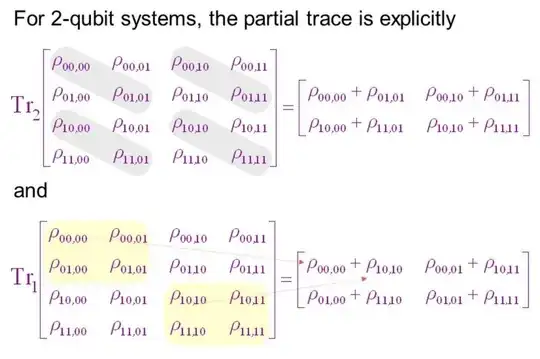I'm trying to self-study some topics about quantum computing and I came across a topic of state separability. Talking about that, I wanted to determine separability on the following state (from Qiskit Textbook):
$$ \frac{1}{\sqrt{2}}|00\rangle + \frac{i}{\sqrt{2}}|01\rangle $$
I know, that it is separable, as it can be rewritten as
$$ | 0\rangle \otimes \frac{|0 \rangle + i| 1\rangle }{\sqrt{2}}, $$
but what's the way to determine if the state is separable or entangled without guessing? It's stated in this question that there are ways to do this and I came also across Peres-Horodecki separability criterion, often called also PPT Criterion.
I must admit, that due to my little previous experience, I don't understand everything well, so I'd appreciate an explanation on the abovementioned state, preferably with algebraic steps written, as they're mostly missing in many explanations of this topic.
My attempt
As I understand it, the very first thing is to rewrite the state-vector as a density matrix $\rho$:
$$ | \psi\rangle = | 0\rangle \otimes \frac{|0 \rangle + i| 1\rangle }{\sqrt{2}} = \frac{1}{\sqrt{2}} \begin{bmatrix} 1\\ i\\ 0\\ 0\end{bmatrix} $$ and thus $$ \rho = | \psi \rangle \langle \psi | = \begin{bmatrix} \frac{1}{2} & -\frac{i}{2} & 0 & 0\\ \frac{i}{2} & \frac{1}{2} & 0 & 0\\ 0 & 0 & 0 & 0\\ 0 & 0 & 0 & 0 \end{bmatrix} $$
And now I should perform the "partial transpose" and find the eigenvalues of the transformed matrix. But I'm really confused here about A and B "party", as I have only one state $| \psi \rangle $. How am I supposed to proceed now?
My attempt 2
I also tried to utilize a reduced density matrix:
$$ | \psi \rangle = \frac{1}{\sqrt{2}}|00\rangle + \frac{i}{\sqrt{2}}|01\rangle = \frac{1}{\sqrt{2}} ( | 0\rangle _A \otimes | 0\rangle _B + i(| 0\rangle _A \otimes | 1 \rangle _B )) $$ and thus \begin{align*} \rho_A &= {\rm tr}_B( |\psi \rangle \langle \psi | ) = \frac{1}{2} ( | 0 \rangle \langle 0| + i |0 \rangle \langle 1| ) = \frac{1}{2} \begin{bmatrix}1 & i\\ 0 & 0 \end{bmatrix}\\ {\rm tr}(\rho_A^2) &= \frac{1}{4} {\rm tr} \begin{bmatrix} 1 & i\\ 0 & 0 \end{bmatrix} = \frac{1}{4} \end{align*}
As we can see, my results seems to be $\frac{1}{4}$, while it should be 1 for a separable state. What am I doing wrong?
